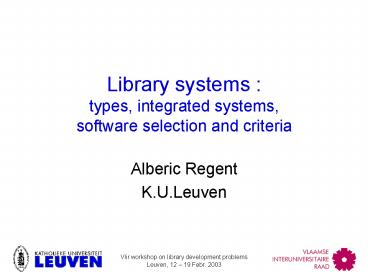Vlir workshop on library development problems PowerPoint PPT Presentation
1 / 20
Title: Vlir workshop on library development problems
1
Library systems types, integrated systems,
software selection and criteria
- Alberic Regent
- K.U.Leuven
2
Content
- historical introduction on library automation
- types of library management systems
- integrated library systems
- commercial versus open source systems
- planning process for software selection
- RFP
- evaluation and arguments for selection
- future trends
3
Historical introduction
- pre 1940 mechanized and pre-computer based
applications ? circulation - 1946 ENIAC (Univ. of Pennsylvania)
- 1951 UNIVAC (first commercial computer)
- 1960 Library of Congress card conversion
- 1966-1968 MARC I MARC II (1968 - )
- - 1970 partial systems (mainly by univ.)
- 1970 - online/integrated systems ( id.)
- 1971 OCLC as Union Catalogue
4
Historical introduction (cont.)
- 1980 growth of commercial vendors
- 1990 - mainly commercial products ( 50)
- taking advance of the technology boost
- PC as personal multifunctional workstation
- move from central mainframe based systems to
client-server technology, local area networks,
... - open systems inter-connectivity
- internet allows global access from anywhere at
anytime ? the virtual library - introduction of multimedia
5
Global networking - OCLC
- founded 1967, became the OCLC Online Computer
Library Center Inc. in 1971 - works as a cooperative global consortium
- governed by members
- 44.000 libraries of 86 countries
- many services and databases
- e.g. Worldcat (48 Mio records / 873 Mio loc.)
- incorp. other networks UTLAS, PICA, WLN, ...
- research (locally and externally)
6
Library Management Systems
- functional
- partial systems (specific areas)
- multifunctional integrated systems (all major
library functions) - organisational technical
- standalone systems (one institution)
- networks (sharing resources, mainly for
cataloguing with increased importance of end-user
search capacities and ILL)
7
Integrated systems
- is one that computerizes a multiplicity of
library functions using one common database
(1992, Cohn, Kelsey Fiels) - today much broader scope integrated systems
include the traditional library functions, but
incorporate access to the internet, to
bibliographic and full-text databases, to other
library systems and networks, to image
repositories, etc.
8
Some commercial systems
- vendors
- Innovative
- VTLS
- Ex Libris
- Sirsi
- Endeavor
- AIS
- Dynix (form. Epixtech)
- Geac
- Follet
- CMC
- products
- Innopac, Millenium
- VTLS-2001, Virtua, RFID, ...
- Aleph 500, Metalib, SFX, ...
- Unicorn, ...
- Voyager, ...
- Adlib
- Dynix, Notis, Horizon
- Advance, Plus, Vubis
- various
- ILIB
9
Some open source systems
- developer
- Katipo Comm. Ltd
- Technology Resource
- Foundation
- ...
- Unesco
- products
- Koha
- OpenBook
- CDS/ISIS (º late 60s !)
- Micro CDS/ISIS (1985)...
- www.unesco.org/webworld/isis
10
Open source systems cost also ...
- server
- hardware operating system
- database support
- support for the open source software
- installation, software and data loading
- staff for implementation and maintenance
- possible subcontracting
- danger for incompatible versions ...
11
Various solutions
- stand-alone solution (one library)
- shared solution (network within one institution,
e.g. large university) - shared solution (consortium-network of many
institutions, e.g. international, national,
regional, by library type, ...) - application service providers (subcontract a
specific service, e.g. a LMS exploitation, to a
providor)
12
Steps in the planning process
- justification
- set-up organisation
- consultancy ?
- specifications
- bidding process
- (Beverley K. Duval, Automated Library Systems,
1992)
- selection of an automated system
- benchmarking
- contract
- installation
- training
- activation
13
Bidding
- Request for Quotation (RFQ)
- Request for Bid (RFB)
- product is identified
- various suppliers possible
- price only criteria
- Request for Proposal (RFP)
- various products possible
- various suppliers possible
- many criteria (cfr Jo Rademakers, Leuven RFP case)
14
Evaluation
- one time cost (purchase)
- recurrent cost (maintenance)
- functionality
- ease / user friendliness
- adaptability (parametr.)
- documentation
- scalability
- reliability
- performance
- vendor quality
- training
- support
- maintenance
- financial stability
- number of staff
- references (...)
- and others ...
- weight coefficients
15
Top 10 arguments for selection
- ease of use for patrons
- availability of modules and submodules
- completeness of these sub / modules
- cost of the system
- cost of the hardware
- need for local programming staff
- reputation of the vendor
- ease of use by staff
- comparable reference site
- previous experience with vendor
- (Peggy Johnson. Automation and Organization
Change in Libraries, 1991)
16
New type of OPACs (sample)
17
New type of OPACs (cont.)
18
Future trends of LMS
- more separation of public access catalog and
staff functions (Leigh Watson Healy, 1998) - tendency towards several systems in parallel
??? - more interest and more demand for users aspects
and services - increased multilingual aspects (Unicode)
- more interoperability (linking with databases
/full text) - more resource sharing
- more ILL (including electronic document delivery)
- self-circulation (reserve, check-out/in, renew,
ILL, ...)
19
Conclusion
- selection of a LMS should be based on real needs
- user needs are predominant
- needs may evolve and systems are not for eternity
(use of standards are a condition for
compatibility and for future migration) - take into account limitations in staff and
finances - open source software may be interesting
- identify the real - in particular the recurrent
cost and support needed for all solutions
(continuity !) - cooperation is essential (networks, shared
actions)
20
Thank you !
- Alberic Regent
- LIBIS-Net
- c/o University Library
- Mgr. Ladeuzeplein 21
- B-3000 Leuven (Belgium)
- alberic.regent_at_libis.kuleuven.ac.be

